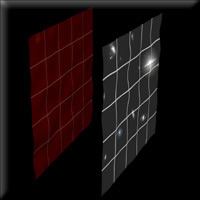Before the Big Bang
Part 3
This theorizing agrees with what we can see in our universe now. The ekpyrotic model leads to a scenario a lot like the fireball of the Big Bang, but there is no episode of inflation. From the outset, the cosmos experienced just one force that accelerated the expansion. That force is still at work today, which means that instead of coasting to a stop, the universe is expanding faster today than it was a billion years ago and will be expanding faster a billion years from now. In short, that one force would also explain the enigmatic force that astronomers have recently named dark energy. Further calculations by Steinhardt and Turok suggest we're at the beginning of a very long process that will eventually result in what appears to be an empty universe. Trillions of years from now, matter will be so widely spread out that its average density will be much less than a single electron per quadrillion cubic light-years of space. That's so close to zero density that there's no meaningful difference.
 |
Step Four: OLD UNIVERSE
Toward the end of one cosmic era, space has expanded to such an extent that galaxies have drifted very far apart. After about a trillion years, most of the stars have burned out, and our universe is nearly empty. But this is not the end of the story. The continued attraction between the neighboring membranes draws them together again, setting the stage for another colossal collision and an ekpyrotic rebirth of our universe. The cycle of collisions between membranes continues into eternity. |
Again, this scenario echoes the predictions of conventional Big Bang cosmology, except that in the model proposed by Steinhardt and Turok, the story does not end there. In the far future, another three-dimensional world still lurks nearby, similarly emptied out after its encounter with ours, invisible and imperceptible to us. Although they bounced apart after the collision, the two branes will exert a force on each other that's analogous to gravity, and they will ultimately meet in another crash, triggering another Big Bang. The cycle of such collisions would be eternal.
"Cyclic-universe models were popular in the 1920s and '30s," Steinhardt says. "But they were based on the idea of a Big Bang followed by a Big Crunch followed by another Big Bang." In these models, the same matter is endlessly recycled, so the entropy of the universe—its tendency toward disorder over time—increases from one cycle to the next. "The result is that each subsequent cycle gets longer," Steinhardt says. "And if you go back into the past, each cycle gets shorter. Ultimately, you still have to have a beginning." In principle, scientists shouldn't care. In practice, most have a very human tendency to abhor the idea of a beginning to time. And most find the prospect of a universe that will end someday to be rather grim. In this new cyclic model, the universe starts essentially empty each time. That means virtually no matter gets recycled. So entropy doesn't increase, and there is no beginning or end to time.
Joel Primack, a physicist and cosmologist at the University of California at Santa Cruz, isn't even all that interested in whether it's right or wrong. "I think it's silly to make much of a production about this stuff," he says. "I'd much rather spend my time working on the really important questions observational cosmology has been handing us about dark matter and dark energy. The ideas in these papers are essentially untestable."
Steinhardt and Turok respond that their theory could gain credence from LISA, a proposed space probe that would look for gravity waves from the early universe. Gravity waves are ripples in the fabric of space-time that were predicted by Albert Einstein. So far, they are theoretical. But by 2020, the LISA experiment—pairs of free-flying satellites that would move apart and together with each passing wave—could either find confirming evidence of inflation or find nothing and thus tip the scales toward ekpyrosis. Inflation theory posits that the entire mass of the universe accelerated to many times the speed of light in a fraction of a second and should have set the entire cosmos ringing with gravity waves. Ekpyrosis, by contrast, which involves a very slow collision between universes, wouldn't generate observable waves. "If we're right," says Steinhardt, "it will be terrifically exciting. If we turn out to be wrong, that'll be disappointing, of course, but it's still important to challenge inflation with alternate theories so we can see how robust it really is."
David Spergel, a Princeton astrophysicist and a member of the WMAP satellite research team, agrees. "Cosmology has to be tied in with superstring theory sooner or later," he says. "There are several ideas out there competing with inflation, and they may all turn out to be wrong. But I'd say this one has the best chance of being right." If it is, we need to rethink our place in the universe—in fact, we need to rethink the universe itself. In the ekpyrotic view of reality, everything that astronomers have ever observed is just a speck within the higher dimensions, and all of history since the Big Bang is but an instant in the infinity of time. This view of creation is far grander than the universe of traditional cosmology or the universe of the Bible.
So far, the pope hasn't weighed in.
Part 1, 2, 3
|

